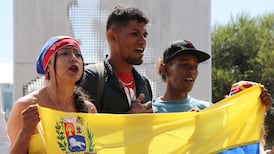In the coming days a Russian Soyuz capsule is scheduled to leave the International Space Station for Earth, bringing home three personnel who have completed months of duties on the facility.
Two of these heading back to Kazakhstan will be Russian cosmonauts but the third will be American astronaut Mark Vande Hei.
In the midst of a war in Ukraine in which Russian bombs and shells are killing Ukrainian civilians and where US-provided weaponry has killed probably several thousand Russians, co-operation is continuing in space, at least for the present.
The war in Ukraine is not only the most serious crisis in Europe in decades, but the tensions it has generated between the US and Russia may ultimately also have an impact 400km above Earth at the International Space Station.
Almost from its inception about 60 years ago, space exploration has had as much to do with politics as with science, maybe more so.
The race to orbit Earth and later to the moon between the US and the former Soviet Union were as much about showing their own people and the broader world which political system was the most advanced.
However, in more recent years space has been one of the main areas of co-operation between the US and Russia.
The International Space Station project stemmed from an initiative to improve US-Russian relations after the collapse of the Soviet Union and to get away from the cold war rivalry between the two powers that marked the race to be first to the moon in the 1960s.
Even though this new co-operation was tested by Russia’s annexation of Crimea in 2014, Russian cosmonauts and American astronauts continued to work side by side on the space station.
After the retirement of the US space shuttle in 2011, and until the private Space X firm came on the scene in 2020, the Americans paid handsomely – about $4 billion (€3.64 billion) – for seats on Russian space craft to bring their astronauts to and from the station.
The Americans, Russians, Japanese and others have their own modules or parts of the space station, but these are largely inter-dependent.
While the fallout from the invasion of Ukraine by Russia has the potential to cause serious problems for the space station project, the messages from both sides have been mixed.
Restrictions on high tech exports to Russia introduced by the Biden administration were designed to degrade its aerospace industry. The US space agency Nasa argued, on the other hand, that the measures would not impact on "ongoing in-orbit and ground-station operations".
However, Dmitry Rogozin, director general of Russian space agency Roscosmos, denounced the restrictions and warned sanctions could "destroy" teamwork with the US on the International Space Station.
Twitter spat
Rogozin has in recent weeks also been involved in a Twitter spat with one of the US's most famous astronauts of recent times and a strong critic of the Russian war in Ukraine, Scott Kelly, who spent a US record of nearly a year in space.
In one instance Rogozin tweeted a video of technicians taping over the flags of the United States, Japan and other nations on the Soyuz rocket that was supposed to launch 36 internet satellites for a UK-based company.
That launch, scheduled for March 4th, did not happen, because OneWeb and the British government, which owns part of the company, declined to meet new demands imposed by Roscosmos on how the satellites would be used.
Kelly responded to that tweet, writing, “Dimon, without those flags and the foreign exchange they bring in, your space programme won’t be worth a damn. Maybe you can find a job at McDonald’s if McDonald’s still exists in Russia.”
Rogozin replied in a tweet that was subsequently deleted: "Get off, you moron! Otherwise the death of the ISS [International Space Station] will be on your conscience!"
In response to western sanctions Russia has also said it will no longer sell rocket engines to US companies. It has also halted launches of Russian-built Soyuz rockets from Europe's space port in French Guiana.
At the same time, Nasa has said it and the Russians are still working toward a “crew exchange” deal under which both would routinely share flights to the space station on each other’s space crafts.
The revival of tensions akin to the cold war comes as Nasa is planning a return to the moon after a 50-year hiatus.
Americans won’t be landing on the moon any day soon. It may be 2025 or 2026 before that happens.
However, the first steps are taking place. Last week Nasa rolled out its new mega rocket known as the Space Launch System at the Kennedy Space Center in Florida, essentially as a dress rehearsal ahead of an unmanned launch around the moon later this year.
















